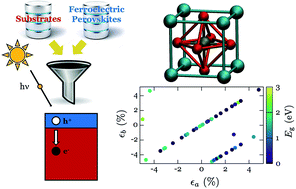Photo-sensitizing thin-film ferroelectric oxides using materials databases and high-throughput calculations†
Abstract
Conventional solar cell efficiency is usually limited by the Shockley–Queisser limit. This is not the case, however, for ferroelectric materials, which present spontaneous electric polarization that is responsible for their bulk photovoltaic effect. Even so, most ferroelectric oxides exhibit large band gaps, reducing the amount of solar energy that can be harvested. In this work, a high-throughput approach to tune the electronic properties of thin-film ferroelectric oxides is presented. Materials databases were systematically used to find substrates for the epitaxial growth of KNbO3 thin films, using topological and stability filters. Interface models were built and their electronic and optical properties were predicted. Strain and substrate–thin-film band interaction effects were examined in detail, in order to understand the interaction between both materials. We found substrates that significantly reduce the KNbO3 band gap, maintain KNbO3 polarization, and potentially present the right band alignment, favoring electron injection in the substrate/electrode. This methodology can be easily applied to other ferroelectric oxides, optimizing their band gaps and accelerating the development of new ferroelectric-based solar cells.



 Please wait while we load your content...
Please wait while we load your content...